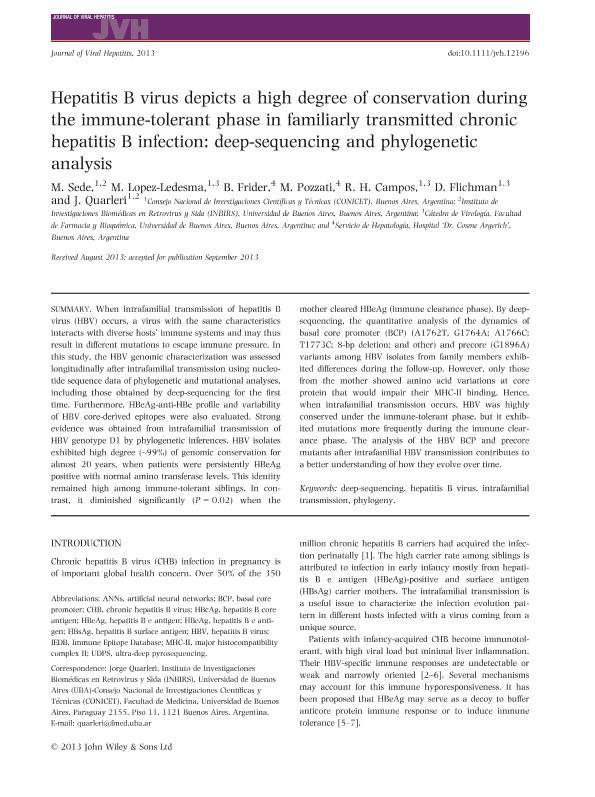Artículo
Hepatitis B virus depicts a high degree of conservation during the immune-tolerant phase in familiarly transmitted chronic hepatitis B infection: deep-sequencing and phylogenetic analysis
Sede, Mariano Miguel ; González López Ledesma, María Mora
; González López Ledesma, María Mora ; Frider, B.; Pozzati, M.; Campos, Rodolfo Hector
; Frider, B.; Pozzati, M.; Campos, Rodolfo Hector ; Flichman, Diego Martin
; Flichman, Diego Martin ; Quarleri, Jorge Fabian
; Quarleri, Jorge Fabian
 ; González López Ledesma, María Mora
; González López Ledesma, María Mora ; Frider, B.; Pozzati, M.; Campos, Rodolfo Hector
; Frider, B.; Pozzati, M.; Campos, Rodolfo Hector ; Flichman, Diego Martin
; Flichman, Diego Martin ; Quarleri, Jorge Fabian
; Quarleri, Jorge Fabian
Fecha de publicación:
09/2014
Editorial:
Wiley
Revista:
Journal Of Viral Hepatitis.
ISSN:
1352-0504
e-ISSN:
1365-2893
Idioma:
Inglés
Tipo de recurso:
Artículo publicado
Clasificación temática:
Resumen
When intrafamilial transmission of hepatitis B virus (HBV) occurs, a virus with the same characteristics interacts with diverse hosts' immune systems and may thus result in different mutations to escape immune pressure. In this study, the HBV genomic characterization was assessed longitudinally after intrafamilial transmission using nucleotide sequence data of phylogenetic and mutational analyses, including those obtained by deep-sequencing for the first time. Furthermore, HBeAg-anti-HBe profile and variability of HBV core-derived epitopes were also evaluated. Strong evidence was obtained from intrafamilial transmission of HBV genotype D1 by phylogenetic inferences. HBV isolates exhibited high degree (~99%) of genomic conservation for almost 20 years, when patients were persistently HBeAg positive with normal amino transferase levels. This identity remained high among immune-tolerant siblings. In contrast, it diminished significantly (P = 0.02) when the mother cleared HBeAg (immune clearance phase). By deep-sequencing, the quantitative analysis of the dynamics of basal core promoter (BCP) (A1762T, G1764A; A1766C; T1773C; 8-bp deletion; and other) and precore (G1896A) variants among HBV isolates from family members exhibited differences during the follow-up. However, only those from the mother showed amino acid variations at core protein that would impair their MHC-II binding. Hence, when intrafamilial transmission occurs, HBV was highly conserved under the immune-tolerant phase, but it exhibited mutations more frequently during the immune clearance phase. The analysis of the HBV BCP and precore mutants after intrafamilial HBV transmission contributes to a better understanding of how they evolve over time.
Palabras clave:
Hepatitis B Virus
,
Intrafamilial Transmission
,
Phylogeny
,
Deep-Sequencing
Archivos asociados
Licencia
Identificadores
Colecciones
Articulos(INBIRS)
Articulos de INSTITUTO DE INVESTIGACIONES BIOMEDICAS EN RETROVIRUS Y SIDA
Articulos de INSTITUTO DE INVESTIGACIONES BIOMEDICAS EN RETROVIRUS Y SIDA
Articulos(OCA HOUSSAY)
Articulos de OFICINA DE COORDINACION ADMINISTRATIVA HOUSSAY
Articulos de OFICINA DE COORDINACION ADMINISTRATIVA HOUSSAY
Citación
Sede, Mariano Miguel; González López Ledesma, María Mora; Frider, B.; Pozzati, M.; Campos, Rodolfo Hector; et al.; Hepatitis B virus depicts a high degree of conservation during the immune-tolerant phase in familiarly transmitted chronic hepatitis B infection: deep-sequencing and phylogenetic analysis; Wiley; Journal Of Viral Hepatitis.; 21; 9; 9-2014; 650-661
Compartir
Altmétricas



